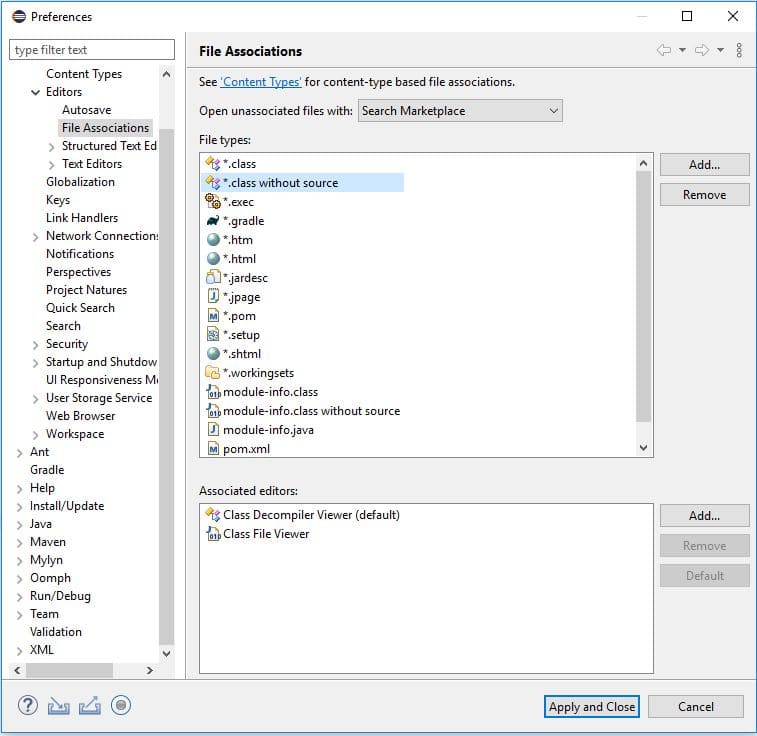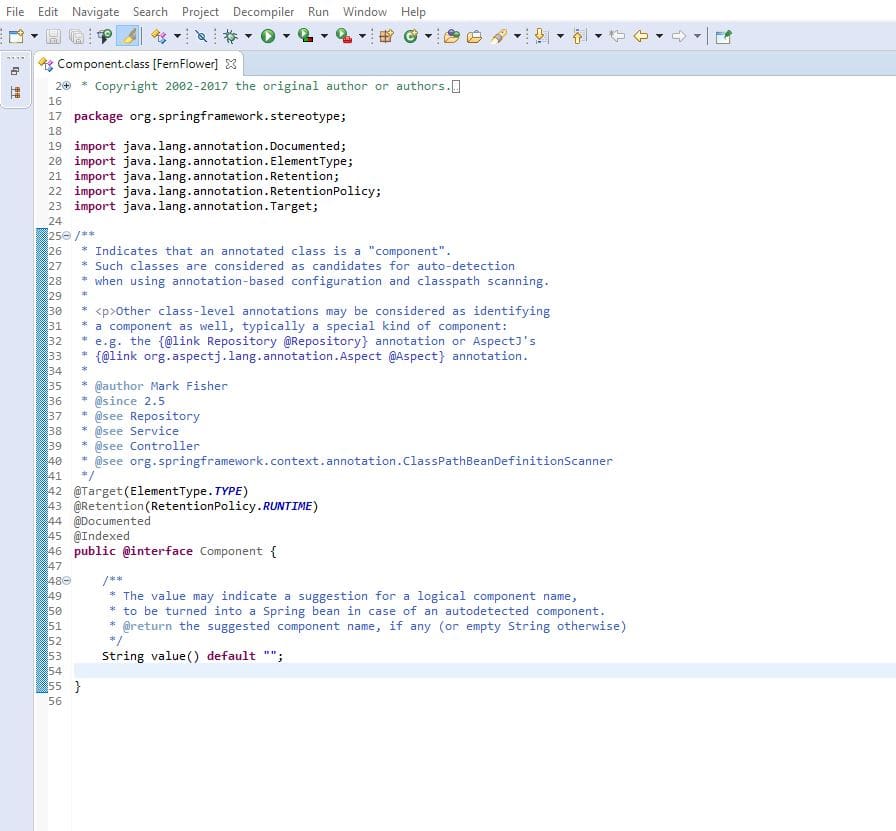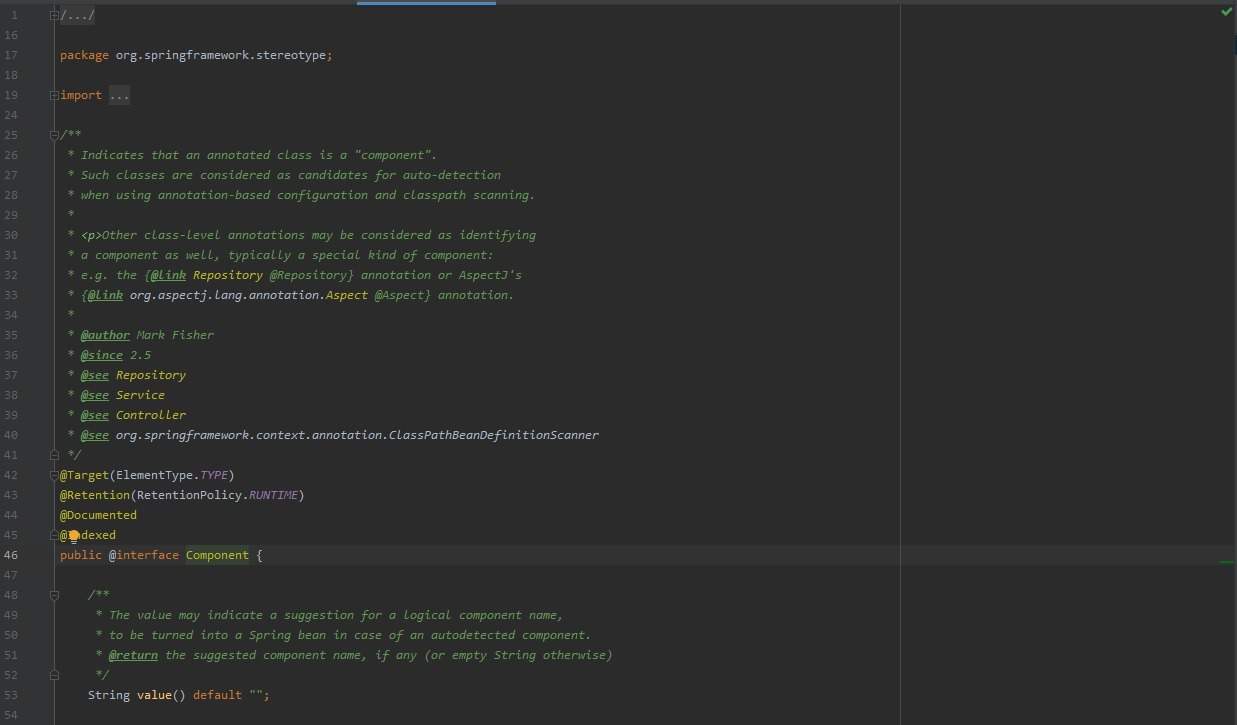1. 概述
在日常开发中,我们难免会遇到没有源码的第三方库或遗留系统。此时,反编译 Java 类文件就成了逆向分析、排查问题、理解逻辑的重要手段。它能帮助我们在缺失源码的情况下,窥探字节码背后的实现逻辑。
本文将介绍几种主流且实用的 Java 反编译方式,涵盖 IDE 集成方案和命令行工具,助你在不同场景下快速上手。
✅ 适用场景:调试依赖库、分析框架实现、排查诡异 Bug、学习优秀设计
⚠️ 注意:仅限合法用途,切勿用于侵犯知识产权
2. IDE 内反编译
现代 IDE 基本都支持类文件的自动反编译,开发时点进去就能看,体验丝滑。相比手动操作,集成在 IDE 中的方式更高效、上下文更完整。
下面以 Eclipse 和 IntelliJ IDEA 为例说明。
2.1. Eclipse
Eclipse 本身不带反编译器,需借助插件实现。最常用的是 **Enhanced Class Decompiler (ECD)**,它集成了 FernFlower、JD-Core 等多个引擎,稳定性高。
安装与配置步骤:
- 打开 Eclipse Marketplace,搜索并安装 Enhanced Class Decompiler
- 安装完成后重启 IDE
- 进入
Window > Preferences > General > Editors > File Associations - 添加
*.class文件类型,并将其默认编辑器设为 Class Decompiler Viewer

- 同样地,为
*.class without source设置关联

使用方式:
- 在代码中按住
Ctrl + 左键点击类名 - 自动打开反编译窗口,顶部标签页会显示使用的反编译器(如 FernFlower)
✅ 推荐使用 FernFlower 引擎,语法还原度高,对 Lambda、泛型支持较好
2.2. IntelliJ IDEA
IntelliJ IDEA 的优势就体现出来了:开箱即用,内置 FernFlower 反编译器,无需额外插件。
使用方式:
- 直接
Ctrl + 左键(Windows/Linux)或Cmd + 左键(Mac)点击任意类名 - 如果该类没有附加源码(source jar),IDEA 会自动调用 FernFlower 显示反编译结果
源码 vs 反编译:
IDEA 还支持下载源码包(Source JAR)。对比非常明显:
- 反编译代码:能看到方法逻辑,但注释、Javadoc、作者意图丢失
- 原始源码:保留完整注释、文档、设计说明
例如,@Component 注解的 Javadoc 明确说明其作用范围和使用建议:
✅ 小技巧:在 Maven 项目中可通过
Download Sources手动获取源码
⚠️ 踩坑提醒:有些公司私服未发布 source jar,只能靠反编译硬啃
3. 命令行反编译
当面对生产环境、远程服务器或无 GUI 的容器时,IDE 显然无法使用。此时,命令行工具就成了救命稻草。
适用于:
- 分析线上 jar 包
- 自动化脚本集成
- CI/CD 流水线中的静态分析
推荐工具:JDCommandLine
JDCommandLine 是 JD-GUI 的命令行版本,基于 JD-Core 引擎,轻量且稳定。
使用示例:
java -jar JDCommandLine.jar my-application.jar ./classes
❗️注意:
./classes参数不能省略,它是输出目录,否则会报错或静默失败
输出结果:
反编译后的 Java 文件会被解到 ./classes 目录下,结构保持原包路径,可直接用 Vim、Nano 或其他文本编辑器查看:
├── com
│ └── example
│ └── service
│ └── UserService.class
↓ 反编译后
├── com
│ └── example
│ └── service
│ └── UserService.java
✅ 场景举例:你在 Kubernetes Pod 里发现某个行为异常的 jar,可以直接
exec进去反编译分析,简单粗暴有效
4. 总结
| 方式 | 优点 | 缺点 | 推荐指数 |
|---|---|---|---|
| IntelliJ IDEA | 开箱即用,体验最佳 | 依赖本地 IDE | ⭐⭐⭐⭐⭐ |
| Eclipse + ECD | 灵活可选引擎 | 需手动配置 | ⭐⭐⭐⭐ |
| 命令行工具 | 适合远程/自动化场景 | 无语法高亮,体验较差 | ⭐⭐⭐⭐ |
✅ 核心结论:
- 日常开发首选 IntelliJ IDEA,省心省力
- 团队统一使用 Eclipse 的,务必安装 ECD 插件提升效率
- 生产排查问题时,命令行工具是必备技能
⚠️ 最后强调:反编译只是手段,真正的价值在于理解代码背后的意图。有条件还是优先获取官方源码或文档,避免“盲人摸象”。


